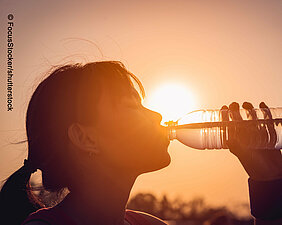Within the last 20 years, climate change has increasingly led to record summers with extended hot weather periods. The warming of the soil can reach the distribution systems and, hence, causing temperature increase, whereby upper limits of drinking water temperatures of 25 °C are exceeded. The effects of this temperature increase on the microbiological drinking water quality are only incompletely understood and will be investigated in more detail within the framework of the project MibiTemp which is funded by the German Technical and Scientific Association for Gas and Water (DVGW).
Current Situation
The temperatures for cold drinking water should not exceed 25 °C. In addition, consumers can expect drinking water to be colourless, clear and cool as well as odourless and tasteless according to several German technical rules (DIN and DVGW). This does not fit with withdrawal temperatures of > 20 °C. The issue of increased water temperatures was firstly recognised several years ago, especially in southern Germany, and was thereafter discussed in the context of DVGW discourses, which revealed a broad concern of water suppliers. The water temperature is a central parameter for physical, chemical and biological processes in the drinking water distribution. The DVGW project MibiTemp (W 202016), in close cooperation with the DVGW project EWaT (J 201904), is investigating the consequences of increased water temperatures on drinking water quality from a biological perspective. The aim of the project is to fundamentally assess the effects of increased water temperatures in water distribution and to derive measures for the prevention of possible microbial impairments for practical use.
Investigation programme
The investigation of drinking water distribution networks from 12 water suppliers is the key aspect of the project. In addition to extended close-meshed routine measurement programmes, biofilm investigations with a total of more than 30 biofilm monitors are carried out. The investigations are accompanied by close-meshed temperature measurements in terms of time and space. Two temperature-controlled model distribution systems enables investigations under defined conditions. The range of parameters investigated includes the indicator parameters of the German Drinking Water Ordinance (TrinkwV) as well as the group of aeromonads, the total cell count and microbiome analyses for a holistic assessment of the microbiology.
First Results
The investigations performed in the summers of 2021 and 2022 revealed so far no abnormalities, but showed a high microbiological stability of the examined waters. The total cell counts in the water body as holistic parameter of water microbiology remained stable over the summers and across the different measuring points in the distribution networks. So far, it has been shown that the distribution of nutrient-poor drinking water and the use of approved materials and components in the distribution systems are significant aspects of microbiological stability even at increased water temperatures. The project will be terminated in 2024.
More information

![[Translate to English:] Prüfstelle-Produktprüfung_Teststand Test centre and product testing](/fileadmin/_processed_/0/9/csm_TZW-Karlsruhe_Pruefung_Geraete-Teststand_377188946c.jpg)

























